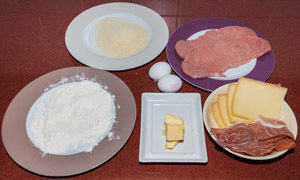
It goes well with a strong red wine, e.g. a Rioja, or a rosé.
Attention! Preparation time approx. 6 hours!
PreparationYou'll need:
|
|
Ingredients (for 2 persons)
For the Marinade
For the Sauce
For the very end
|
|
Ingredients for the couscous salad (side dish)
|
|
The MarinadeBrush the bottom of the roaster with 2-3 Tbsp. plain olive oil. Cut the lamb shoulder on the skin side several times in both directions about 1 cm deep. Place briefly on the side in the roaster.
Peel 4 garlic cloves and put them in a suitable cup or bowl -
puree all this with a hand blender. Add: approx. 1/2 tbsp thyme leaves, 1
tsp paprika powder, 1/2 tsp turmeric, 1 tsp chilli flakes,
1 tsp salt, 25 g butter. Puree everything finely and then rub well
with your hands into the incised top of the lamb shoulder - also into
the incisions. Preheat the cooker to 190℃ fan oven. |
|
The other ingredients for the lamb and start the roasting processRoughly chop the 2 onions, for 180 g. Spread around the lamb shoulder. Also: 10-15 half-dried dates, 1 large cinnamon stick, 2 bay leaves. Add 375 mL white wine and 750 mL water. Cover the roaster and place it in the oven. After one hour, turn the temperature down to 150℃ and continue roasting for another 4 hours (perhaps checking 1 hour before the end to see if you need to add more water. It should not drop below 2 cm in height). I always prepare the couscous salad after the first hour. See next section. |
|
The Couscous Salad
|
|
Last stepsAs soon as the 4 hours at 150℃ are up, remove the roaster from the oven and carefully remove the meat (be careful - it falls apart very easily!) and park it on a plate in the oven, still warm but switched off. Remove the cinnamon stick and the 2 bay leaves from the sauce and then (if you have the right roaster, otherwise just tip it into a large pan) reduce the sauce on the hob over a high heat if necessary. You should then have about 300 mL of juice left. To serve, place the meat on warmed plates, pour the sauce over it, sprinkle a few of the almonds on top (place the rest in a small bowl on the table) and serve with the couscous salad in separate bowls (don't forget the olive oil, lime juice and pomegranate syrup). |
|






















































